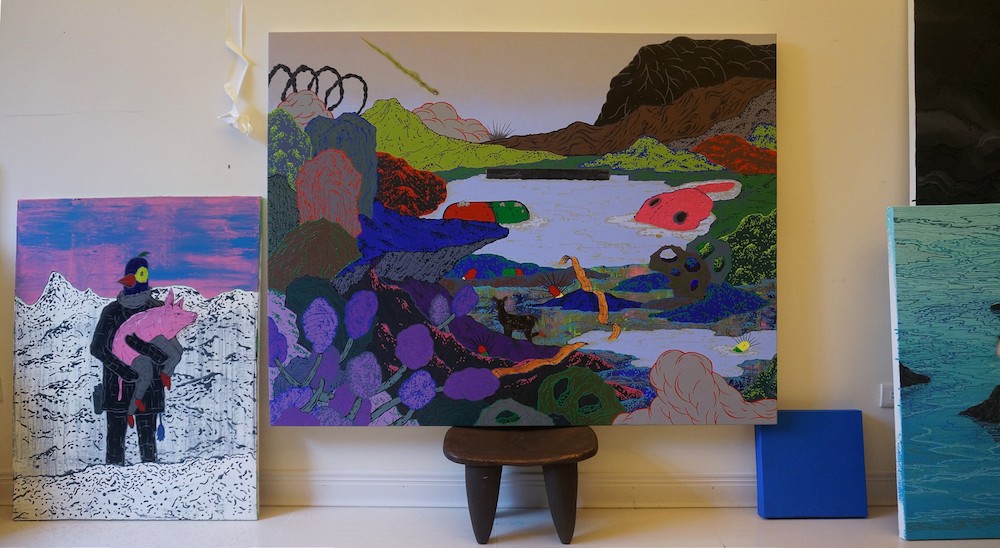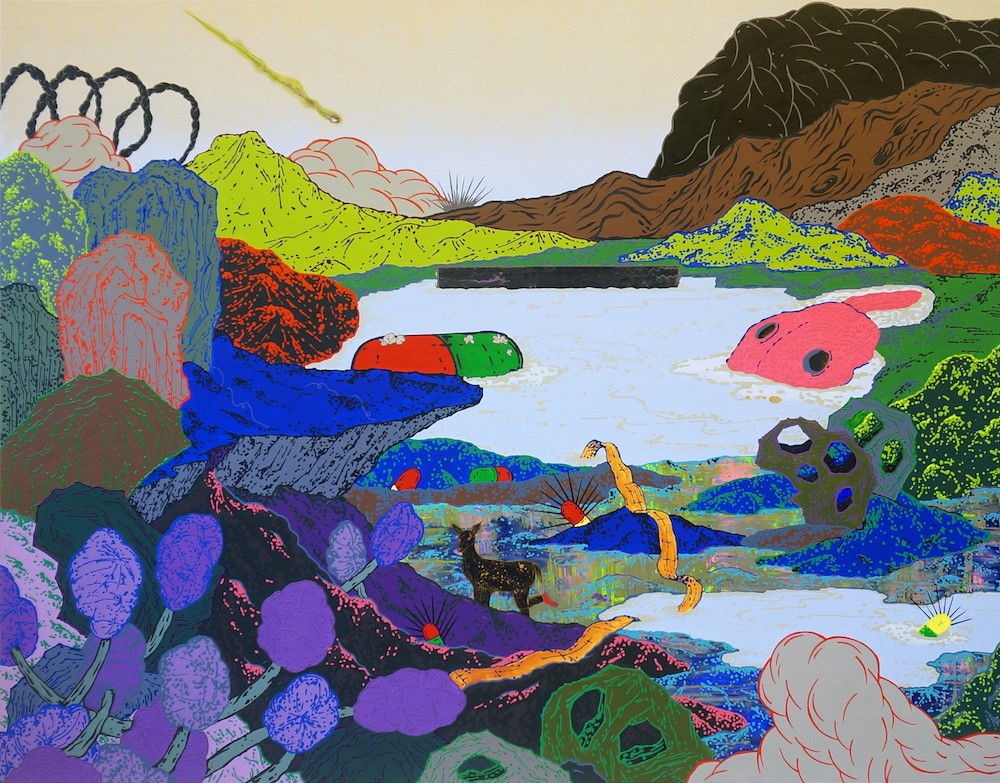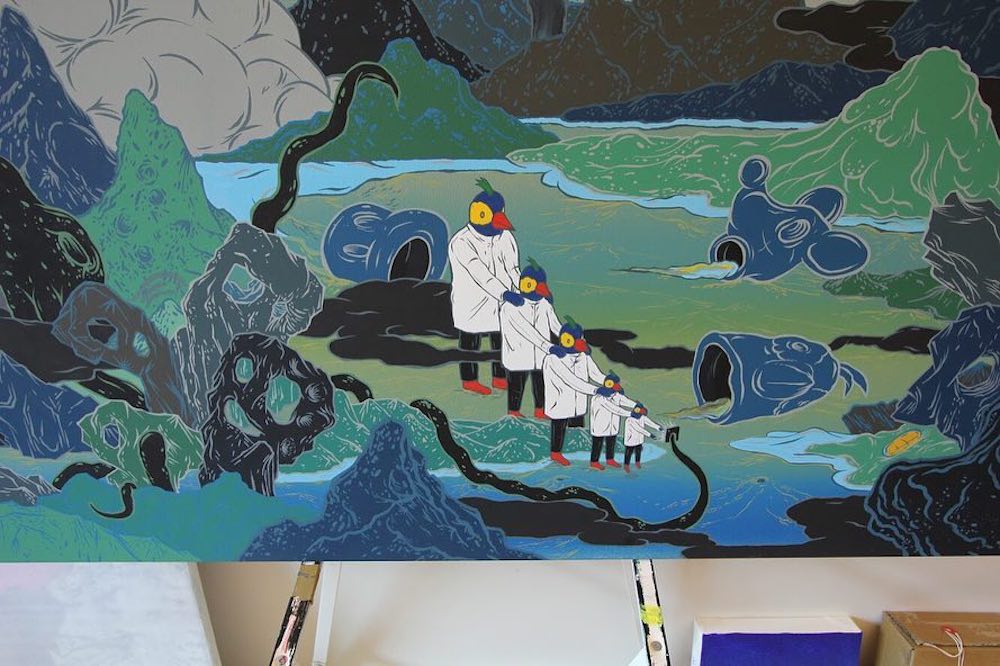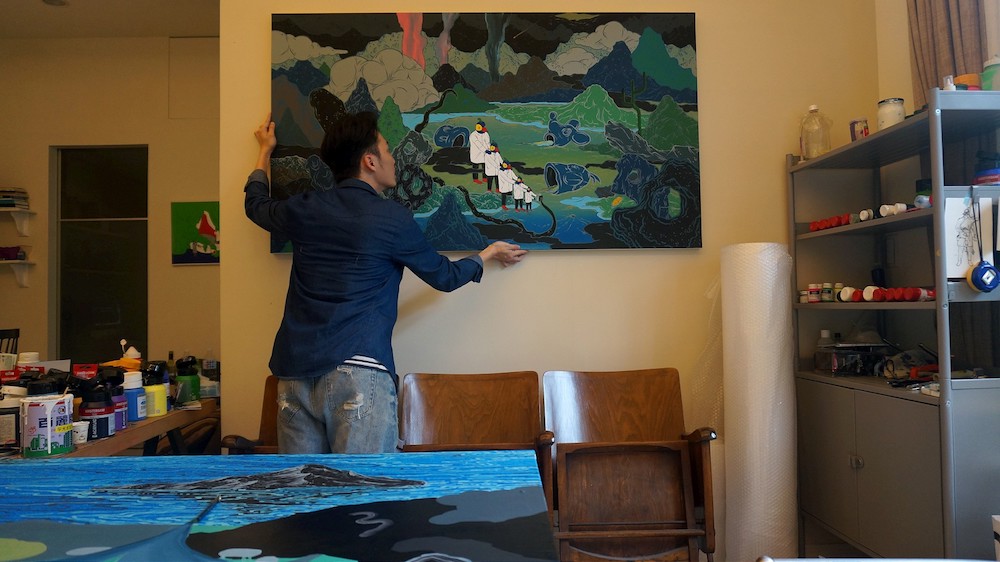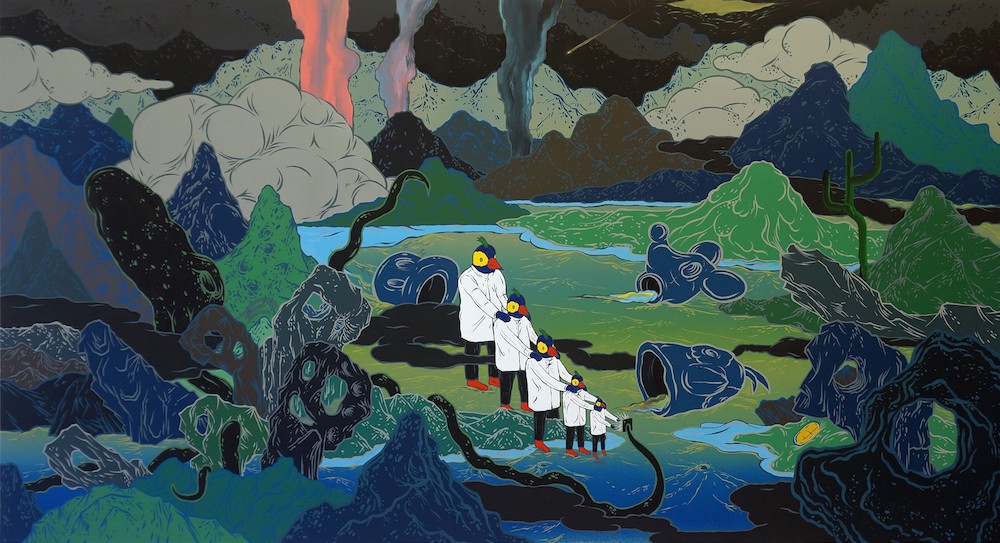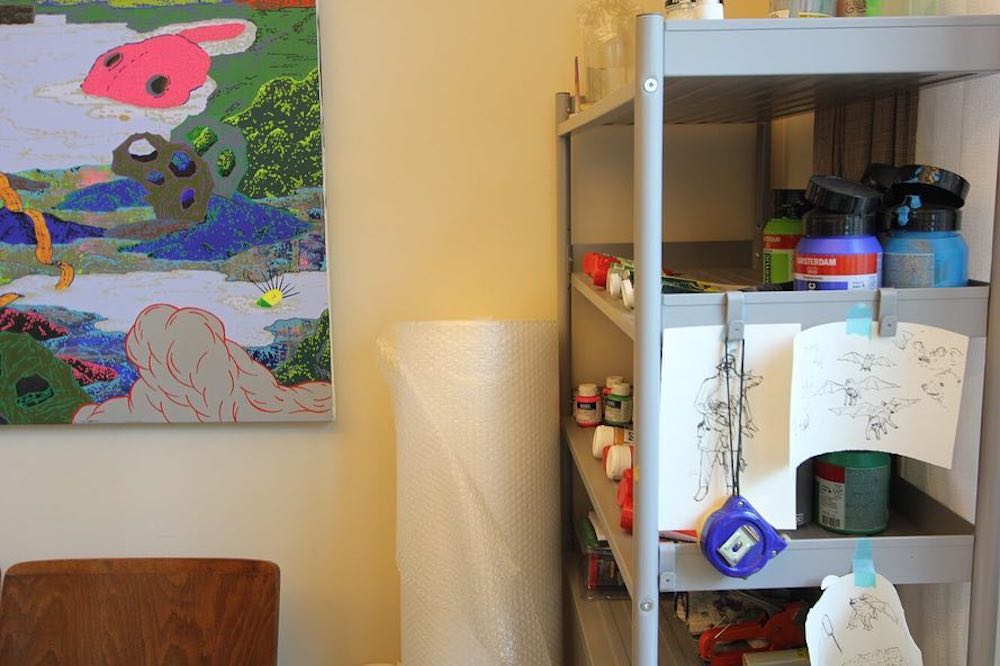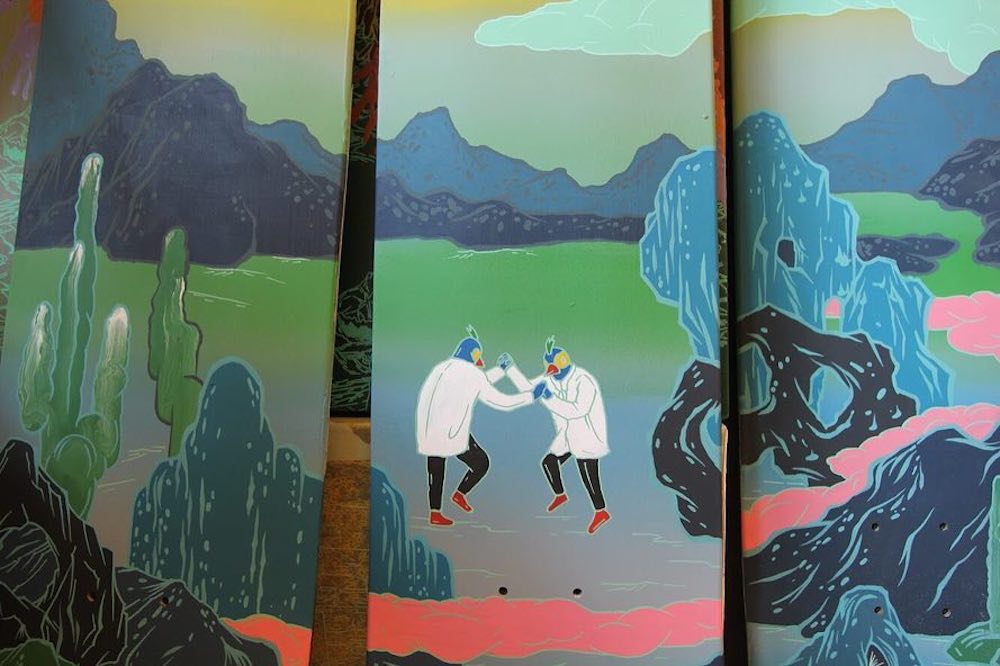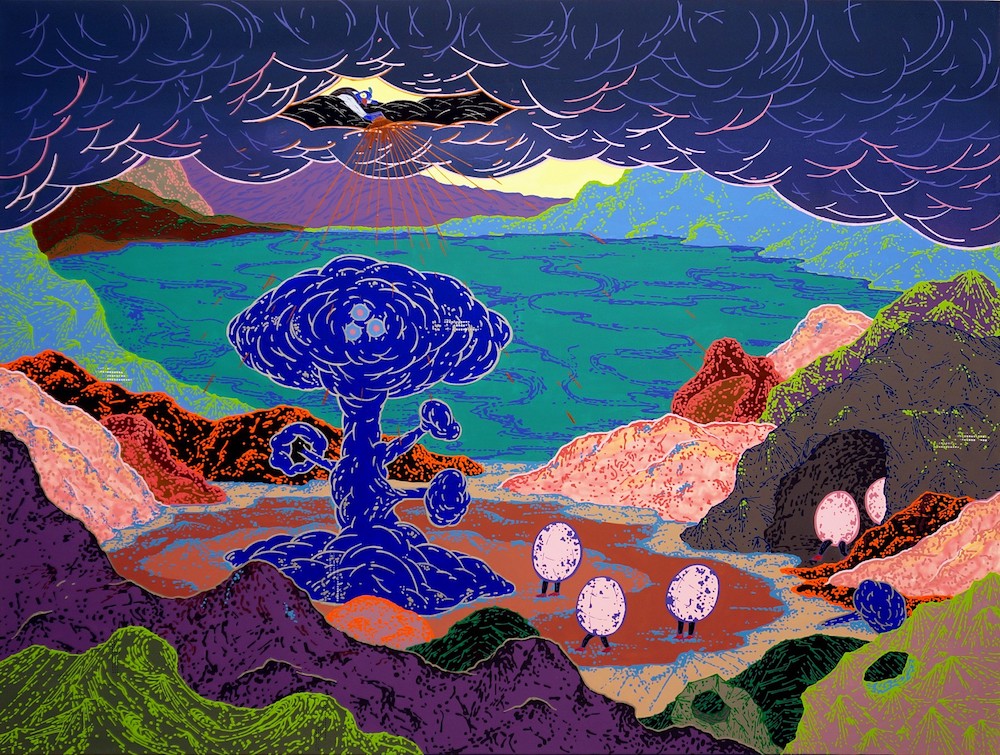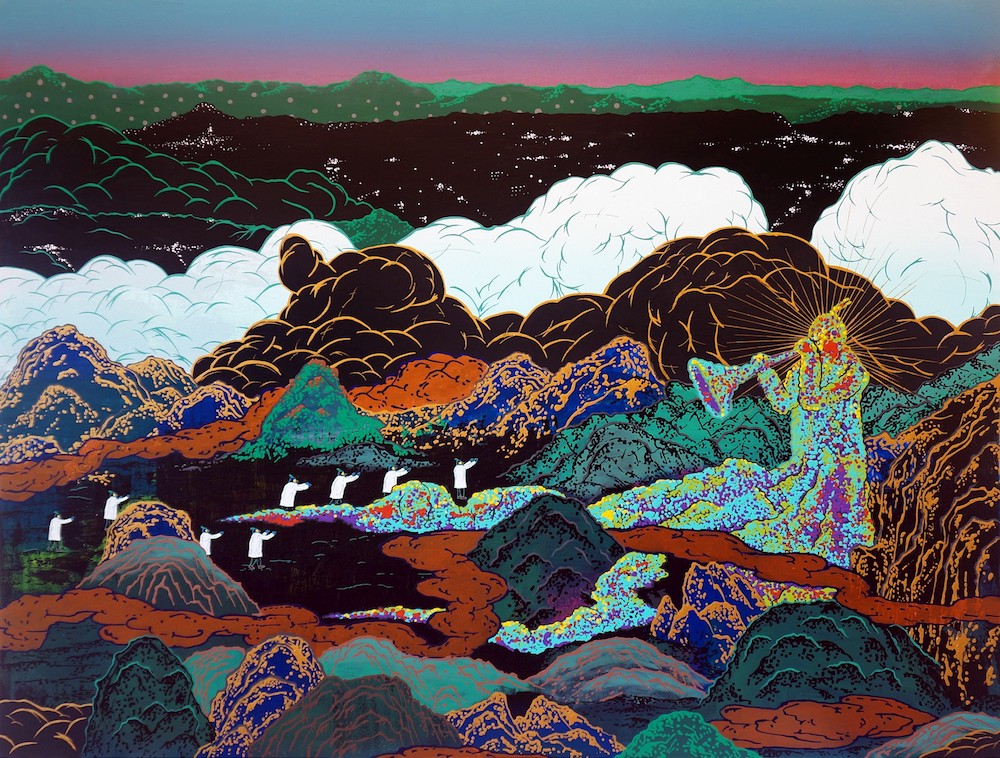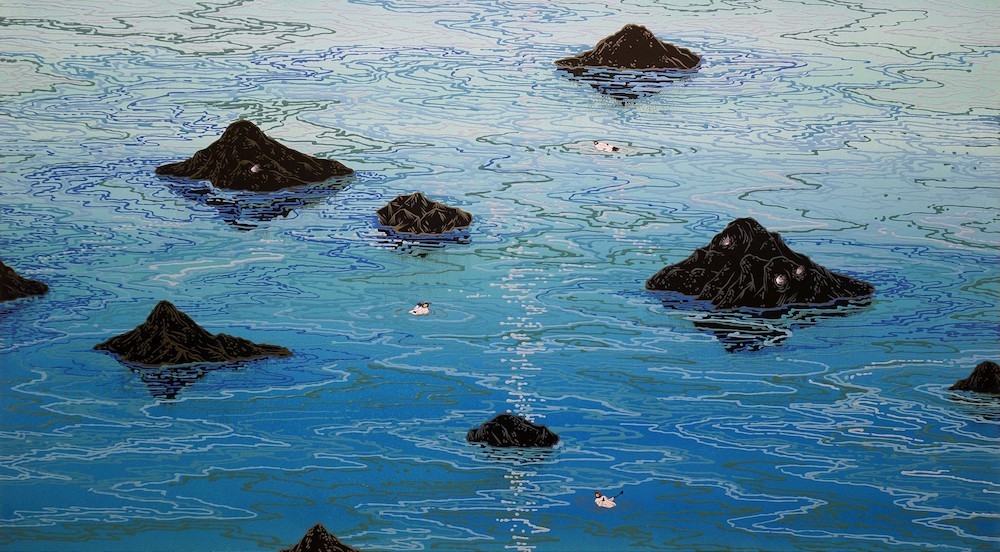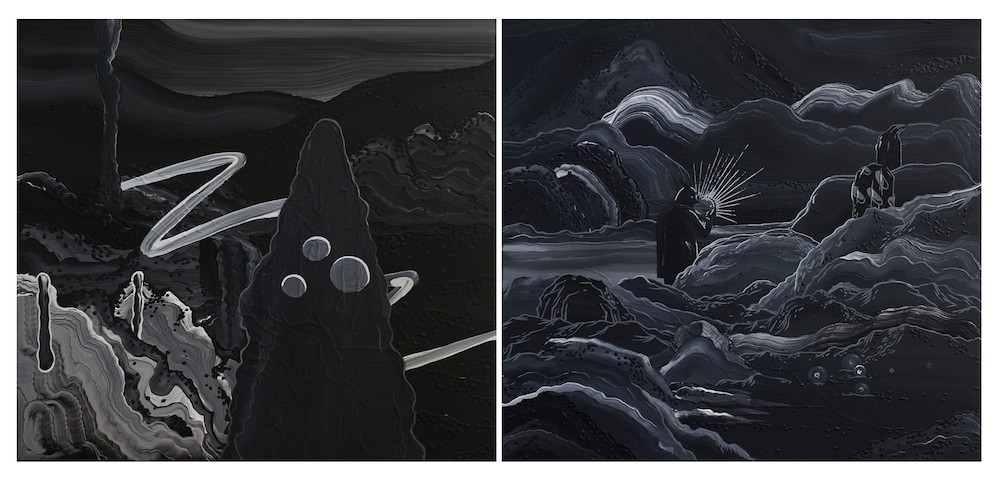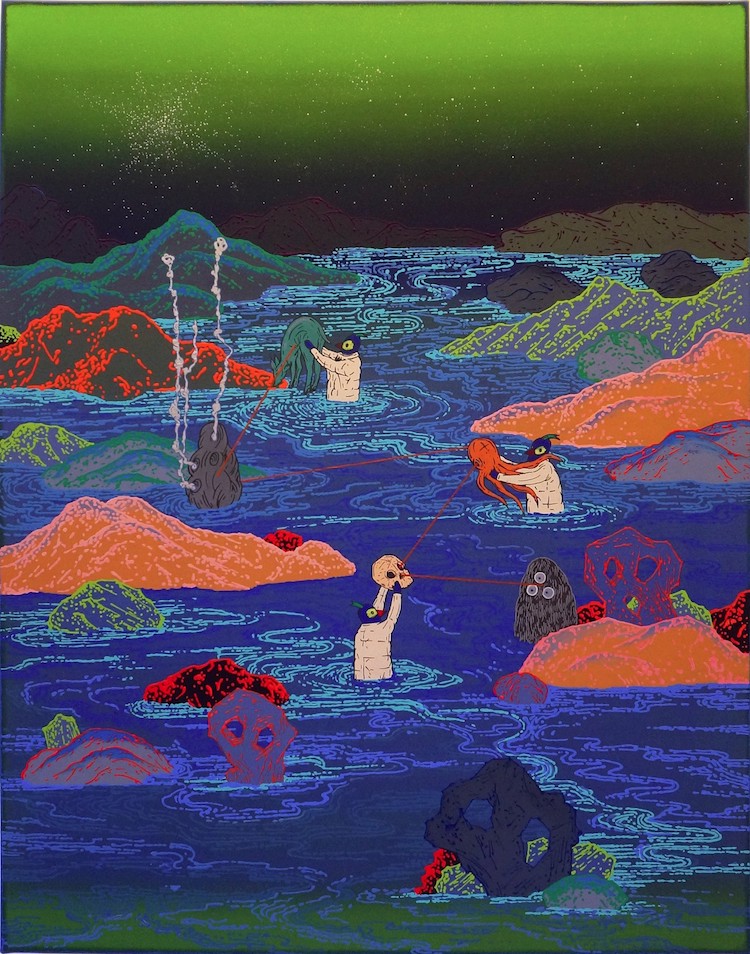We first noticed the work of Teng-Yuan Chang at Art Central in Hong Kong back in March, and captivated by the trippy visuals that mix illustration, painting, and narration along with elements of graffiti. Working through a variety of mediums, the Taiwan-born artist constructs surreal landscapes and scenarios using a distinctive color palette that prophecizes doomsday archaeology. Enthralled by paintings and video/animation work that fluidly blend elements of Eastern and Western traditions, we asked for a virtual peek into his studio, ahead of his upcoming solo show, Prism, Lake, Light at iArt Gallery in Hsinchu City, Taiwan. Luckily, Teng was nice enough to have a chat about his visions and artistic practice.
Sasha Bogojev: What type of setting do your images show?
Teng-Yuan Chang: My works are mainly founded on a doomsday saga, which I call, "doomsday archeology" or "future archeology." Imagine, it is a few thousand years after doomsday when aliens landed on earth. With archeology, we are trying to find out human civilization before the doomsday. Inspired by a program on the Discovery Channel, the archeologist explained that even if we have very high technology, we still cannot understand many of the relics excavated in archeological sites. We still cannot figure out their original usage and the meanings they represent.
I find that very interesting. Will creatures excavate Duchamp's work Fountain, a toilet bowl, or Demien Hirst's The Physical Impossibility of Death in the Mind of Someone Living, a shark's specimen without knowing what are they for? So, I came up with an interesting hypothesis and it opened up my future archeology series. In these works, there is an alien “Parrot-man” who came to earth. He studies human civilizations of the earth before the doomsday with archeology. I use “parrot” as the image set up for this alien mainly because of the ability to imitate human voices, though not knowing the meanings of the sounds it imitated. Therefore, for me, “parrot” is a sign of misunderstanding. So, I set up the plot to have a parrot coming to earth after the doomsday. Through intentional “misunderstanding,” I would like to point out the absurdity of the contemporary era. 
Is this based on anything from real life?
Yes and no. Before answering this question, I would like to explain that “I would like to create a fictional plot” to interpolate into contemporary artistic creations because I think that in the contemporary era, every person is compelled to absorb increasing information every day. For us, much of the news that appears to be absurd is actually facts. Meanwhile, much of the news that appears to be authentic turns out to be fake. In other words, people in the contemporary era can no longer distinguish the real from the unreal. The boundary fades away gradually. Therefore, the issues treated in my works are the fusion of real and unreal information in the real world.
Many of your works feel like they portray the same surreal landscape, so is each work a continuation?
I like a traditional Chinese landscape painting, especially the techniques of mobile perspective or the “signification of landscape." In painting, I always use the technique of mobile-perspective because it makes the world depicted in paintings look familiar and strange at the same time. It resembles the world after doomsday as I imagine it to be.
At the same time, I have strong feelings about the meaning of signification in landscape painting. The mountains, the rocks, and even the leaves are not actually authentic in appearance. In fact, they are the result of transformation and signification. I applied this thinking into my paintings. I am good at signifying the brushstrokes and techniques in paintings and putting the signifiers into the scenes; for example, the technique of texture strokes, the halo in classical religious paintings, the lines in comics, and more. Therefore, my completion of a painting is not done by “painting,” but by “editing.” I think because my trajectory in painting has been different, something weird always appears. It is something I want.
How much of your personal thoughts and emotions are put into the work?
I expect viewers to see a story presented in the series when they see my work. With the change in time, life experiences increase or change, therefore, I have different thoughts at different times. I always put the observations of life at the moment into my works in personal ways. Therefore, I would say, if you read carefully–not just watch but read–my paintings, you will be able to see the changes in my life, different issues that concerned me and my thoughts at different times. I hope the whole context of my artistic creation is a serial story because I believe that by changing constantly, I can transcend the trends and exist.
What images influence your work?
When I am not creating, my interest is to observe contemporary society where we exist. I think, especially living in present times, inspiration is everywhere; but the important thing is how to transform these inspirations into my own creations. For example, Taiwan has the highest density of news channels in the world, no matter whether they are TV news or web. They broadcast news 24-hours a day without stopping, and the contents always come from the spectacular messages posted by anonymous people in web forums. I think similar conditions did not other times or in other places. Therefore, I observe them constantly. Such phenomena have become the inspirations for absurd scenes in my works.
What is more important to you, the narrative of the work or its visual appearance?
I think each of these functions differently in my works. The stories in my works are the reference points of context for my continuous artistic creations. I create according to stories' questions of, “what should I do next? What should the scenes be like? What are the functions of each role?" …and more. However, in the process of creating stories through my works. there is a conversion machine. I throw things of interest into this conversion machine that converts the issues into my conditions. Then, I put them appropriately in my paintings.
When I put these converted issues into the painting, they will make the scenes stop in the middle, like pressing the pause button when playing a video. I think such visual effects are very interesting. Like an open platform, viewers will find clues in the pictures themselves and assemble them within their own stories.
What is your work process for a single piece?
Every time I stand in front of a plain canvas, I must re-build relationships with the picture. Like walking in the mist, I fathom my way slowly. When the direction is assured, I will spend more time “integrating” the picture's elements, like sorting out files or a semi-finished picture, so it looks like fragmented words or phrases with punctuations scattered around. What I do is to sort these things out into something orderly.
Aside from canvases, what other types of works do you create?
I also create animations of spatial installations, or, I integrate painting with animation. I feel the media of painting and animation are complimentary in the context of artistic creations and help me present things more clearly.
Why do you prefer working with a darker color palette?
I always explain that I use color psychology when color matching. It means the sky in my painting is not 'sky blue'; leaves are not green. All the colors are readjusted like shuffling playing cards. I prefer stronger and darker colors to brighter color matching. This kind of color matching allows viewers to tune themselves into a more sensitive state when viewing my works. It is the feeling I want from them.
What type of atmosphere do you want to create in your work?
Like a detective. I like to put fragmented clues into my works no matter whether they are form, color, composition, or anything else. When a viewer appreciates my works, I hope that they do more than just watch. I prefer for them to read – read the clues in the pictures carefully. Like a detective, they are encouraged to find out their stories and interpretations with logical reasoning. If the works have such an atmosphere of conditions, I think they will change constantly in an organic state.
Any favorite series of works, projects, or exhibitions you've had so far?
I like the new sub-topic I started in 2018 – the Light on Faces series. It translates to the blue light projected onto people's faces when they use smartphones. The relationship between people and this blue light is just like that of plants and the sunlight. The light nurtures the viewer. It seems as though we will wither without being bathed with blue light wither. I think that only the faces of people of our generation are radiated by such light. The new relationship between light and people is the symbol of this era.
Did you have any shows or introductions of your work in the West?
Up to now, I have participated in art fairs in London and Cologne and resided in ISCP in 2014 in New York. I expect more opportunities for Euro-American art lovers to see my works in the future.
What do you have planned for the near future?
Now, I am preparing for a new solo exhibition in Hsinchu, Taiwan and a joint-exhibition in the latter half of this year. On a long-term basis. I hope soon to reside in other cities so that I can experience different environments and atmospheres in order to create cozy and interesting works continuously.
Teng-Yuan Chang's "Prism, Lake, Light" opens at iArt Gallery in Hsinchu City, Taiwan on June 1, 2019, and is on display through July 27, 2019.

